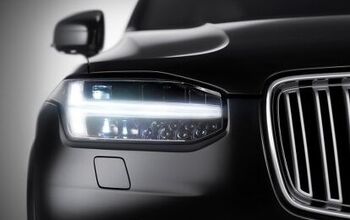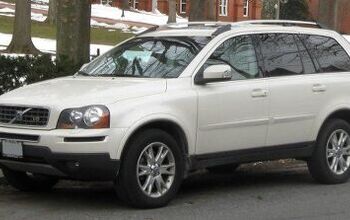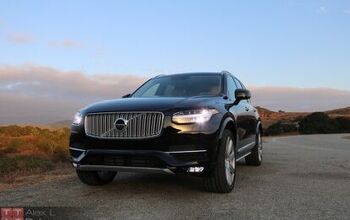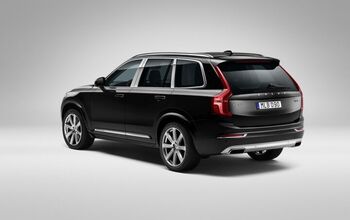Volvo's New XC90 Is Soaring; Other Volvos Are Tanking
We said the new Volvo XC90 would need to sell very well. It is, in fact, selling well. And given the sharp declines Volvo is reporting with every other model, we may have understated the need.
Globally, Volvo reported an all-time record number of sales in calendar year 2015. In the United States, however, even with the second-generation XC90 displaying signs of recovery, Volvo sales in 2015 were half the total achieved by Volvo 11 years earlier.
But in early 2016, Volvo’s big new SUV isn’t simply “displaying signs of recovery.”
Nearly half of all Volvos sold in America in the first-quarter of 2016 were XC90s.
Volvo is therefore on track for U.S. sales to climb to a nine-year high. Yet, aside from the XC90, Volvo’s U.S. operations are displaying many troubling signs.
Over the first three months of 2016, non-XC90 Volvo sales are down 37 percent, a loss of more than 5,000 S60, S80, V60, XC70, and XC60 sales in a market that is producing greater overall new vehicle sales volume than during the record-setting year of 2015.
The age of numerous Volvos plays a large role in the brand’s non-XC90 downturn. The XC60, Volvo’s best seller at this time last year, launched in 2009. The XC70, U.S. volume of which is now about one-fourth what it was 14 years ago, is older than the XC60. Production of the S60 sedan began in 2010. Volvo’s recent debuts, the V60 and Cross Country versions of the S60 and V60, are based on that six-year-old second-generation S60.
Volvo’s outdated S80 is about to be replaced by an all-new S90 sedan and V90 wagon, XC90-based cars with real appeal. Historically, stylish big Volvos weren’t forces with which to be reckoned in the U.S. market. S80 sales plunged 83 percent between 2008 and 2015, the third consecutive year in which Volvo sold fewer than 2,000 S80s in America. (Volvo sold 15,359 S80s in 2002 before sales declined in 11 of the following 13 years.) Not only is a Volvo not the obvious choice in the S90’s class, but the obvious choices are already suffering as consumers increasingly reject big sedans in favour of similarly-priced utilities. Through the first-quarter of 2016, U.S. sales of the Mercedes-Benz E-Class are down 24 percent, BMW 5-Series are down 20 percent, and Audi A6 sales are down 30 percent.
Volvo surely won’t allow its formerly popular models to linger unreplaced forever, as the now Chinese-owned Swedish automaker did with the XC90. 2017 should see a new XC60; 2018 is expected to bring a third-gen S60 and its offshoots. And we can expect to see North American imports of Volvo’s next-gen entry-level models, too, including an XC40 to take on the Audi Q3, BMW X1, and Mercedes-Benz GLA.
In the meantime, the XC90 is covering all the bases; scoring goals and defending the net; throwing touchdowns and receiving punts. Having just spent a week with a 2016 Volvo XC90 T6 Inscription, it’s safe to say the XC90 isn’t perfect. It isn’t as quiet as I expected, its ride quality becomes choppy (especially on 21-inch wheels), a few common premium components (power tilt/telescoping wheel and power folding seats, for example) are missing, the supercharged and turbocharged 2.0-liter four-cylinder isn’t terribly responsive off the line, and the auto stop/start can be gruff.
The new XC90 nevertheless is mostly pleasant to pilot, its interior wows where so many of its rivals bore, and it’s full of thoughtful elements (second-row built-in booster, numerous storage cubbies and hooks, abundant mounting points for different OEM barriers, hugely adjustable seats).
It’s therefore not surprising that, year-over-year, U.S. XC90 sales have now increased in 11 consecutive months. March sales climbed to 3,000 units, just the second 3K month (the other being December 2015’s 3,135-unit performance) since December 2007, a 99-month span. Of the 16,361 Volvos sold in the United States so far this year, 48 percent were XC90s.
Volvo USA averaged 35,000 annual XC90 sales between 2003 and 2007. 2016 sales are projected to climb beyond 30,000 units for the first time since then. This rebound is occurring even though the XC90 must deal with more rivals now than when it was launched, including the Audi Q7, Infiniti QX60, and Land Rover Range Rover Sport. Plus, two vehicles which didn’t sell quite as well as the XC90 in 2004 — the BMW X5 and Mercedes-Benz M-Class — are now genuinely high-volume competitors the XC90 won’t soon catch.
Inside the XC90’s own showroom, however, the key difference in Volvo’s overall U.S. performance is rather obvious. When XC90 sales peaked at 39,230 units in 2004, Volvo also sold 100,000 other vehicles in America. In 2016, as Volvo’s U.S. dealers deliver more than 30,000 XC90s, they’re unlikely to deliver more than 40,000 other Volvos.
[Images: © 2016 Timothy Cain/The Truth About Cars]
Timothy Cain is the founder of GoodCarBadCar.net, which obsesses over the free and frequent publication of U.S. and Canadian auto sales figures. Follow on Twitter @goodcarbadcar and on Facebook.
More by Timothy Cain
Latest Car Reviews
Read moreLatest Product Reviews
Read moreRecent Comments
- Hari Your route home sounds like the perfect stretch for a car like the Alfa Romeo Giulia. Its renowned handling and dynamic performance make it an ideal match for those curves. For enthusiasts or potential owners interested in understanding all the capabilities of the Giulia 2017, the owner’s manual is an invaluable resource. Check it out here: https://chatwithmanuals.com/automobiles/2017-alfa-romeo-giulia-owners-manual/. Our AI-powered chat makes navigating the manual simple, helping you quickly find specific details about the car's features and specs. Perfect for making the most out of those driving moments and truly understanding your vehicle!
- Dale I'd consider the RAV4 if the Prime were on the table as paying for gas is for suckers. Otherwise, we have a couple of Mazdas and they are swell. I've driven older versions of both and the CX-5 is a nicer place to live.
- Haran Spot-on review of the Mercedes-AMG GT’s price adjustments and new features! For those intrigued by the all-wheel drive and enhanced features of the latest model, you can delve deeper with the complete operator's manual available here: https://chatwithmanuals.com/automobiles/mercedes-amg-gt-operators-manual-edition-c2020/. It’s a fantastic resource for understanding all the specs and new additions without getting bogged down by the complexity typically associated with car manuals. Chat with the manual using AI to quickly find exactly what you need to know about this sporty beast. Perfect for those who appreciate detailed insights on their luxury investments!
- Flashindapan Beautiful color combinations. I assumed they stop selling the TT here at least five or six years ago.
- Carson D Just don't be the whistleblower who reports on the falsification of safety data. That's a deadly profession.




































Comments
Join the conversation
Volvo just reported 1st quarter 2016 profits of $392 million , which is more than half of the full year 2015 profit of $775 million. And the $775 million 2015 profit was triple the 2014 profit. Volvo is indeed soaring. And this is just based on the all-new XC90? One wonders what the profits will be when the other 8 all-new models come out in the next few years.
For months and months, there were only 2-3 XC90's on my dealer's lot, one of the biggest in the nation. (which is still not that big, being Volvo). Today, there are 46 XC90's listed in their inventory. More than any other type they sell, including the popular XC60. Meanwhile, XC60's are about $10,000 off MSRP at TrueCar. Obviously they canibalized some of its sales. But these inventory numbers are telling me Volvo needs to let go of the dream and admit that, like most brands, sales are slowing, the new has worn off, and it's time to start the incentives.